The 50 States Project is a series of candid conversations with interior designers across the country about how they’ve built their businesses. This week, Honolulu-based designer Shaolin Low tells us why she’s eager to expand the home furnishings offerings on the island, how she’s planning to give back to her local community—and why she doesn’t think of herself as a creative.
Did you always want to be a designer?
Not even a little bit. My [paternal] grandfather was a contractor. He immigrated to Hawaii from Hong Kong and was in the construction business, and my dad ended up taking over that business. On my mom’s side, my grandfather owned a large lumber and building supply store in Stuart, Florida, and my mom went back to school to become an interior designer later in life, while I was in college. But I think because I grew up on job sites and around the construction business, I didn’t think it was anything interesting.
I grew up in Hawaii, then spent a year in London for a study abroad program. I traveled a bunch then, which exposed me to a whole different aesthetic and culture. Those trips really opened my eyes to art and architecture. But even as I was absorbing all of this, it wasn’t like I was thinking, “I’m going to go be a creative now,” you know? I still don’t really identify as a creative person.
After college, where I studied public relations, I fell into event planning and production, which I’m really good at because I’m hyperorganized. I love numbers, running teams and working with clients—all that stuff came really naturally to me. I lived in New York and San Francisco, and traveled a bunch for work. But ultimately, I got so burnt out—I was [planning and producing] Oprah’s The Life You Want tour, with these amazing speakers like Elizabeth Gilbert who were so inspiring and so amazing, and I just felt so jaded. I realized that if I’m not excited that I’m doing a tour with Oprah, something’s not right, you know? So I took six months off and traveled throughout Asia. While I was there, I realized that many of the places I was visiting were very similar to Hawaii in terms of climate and aesthetic—which helped me realize that’s actually where I belong.
Had you been resistant to returning?
It’s always been so sleepy for me. I’m very much a city girl—everyone who meets me here is like, “You’re from New York, right?” No, I grew up here. But growing up, I never felt like this was my vibe.
As I was trying to figure out what to do—I didn’t want to move to Hawaii without a job, but there aren’t really events to produce there—my mom suggested that I buy her home staging company from her. She had graduated from interior design school, but hadn’t wanted to work for a firm and had gotten into home staging, but she was not loving it. She said, “It will float you until you figure out what to do.” So I bought it from her and dove into home staging.

How did running the staging business go?
I got access to a lot of homes, and I got to see how people were living. I also realized that I’m pretty good at seeing a sofa and knowing if it will fit on the wall or it won’t—just naturally having that visual [ability]. But at the same time, all my event contacts were like, “You’re back in the U.S.? Can we fly you out for this project?” So I was doing both: running the home staging company and being a freelance event producer. I did that for a year. Then I met my husband and got pregnant with our twin girls six months later, and I couldn’t travel to do events.
Is that what prompted you to shift your focus?
Well, that and the babies. I thought I would be the kind of mother who would just have a full-time nanny, because I’m so ambitious and driven. And then the complete opposite happened: I became a mother, and I was like, “This is my purpose. There is nothing else I want to do with my life.” I was obsessed with them. And so for two years, I stayed home with my girls and did home staging on the side.
Our daughters turned 2 in December 2019, and then COVID hit in March 2020. They started changing, in the sense that I was no longer the center of their universe—I could feel energetically that they wanted variety, but it wasn’t sad. It felt like mutual growth for all of us, you know? So then I spent all of 2020 being like, “What am I going to do with my life?” Home staging was great, but it wasn’t a challenge for me. I knew I could keep it going, because it’s a good business, but it doesn’t drive me.
What was it about the business that didn’t keep your interest?
Some people love it, but for me, it was very rinse and repeat. And [the products are] totally shitty stuff. You don’t ever want to invest in [quality furniture], especially on an island—you don’t want to ship things in because you’re losing money.
I started thinking about becoming a life coach and did training for that, because I love talking to people, hearing their stories and helping them out. But my mom kept saying, “You should be a designer, you should be a designer.” And I was like, “Mom, you make it look exhausting, overwhelming, difficult and not moneymaking.” I resisted it for so long. Finally, she bought this course called Interior Design Standard by Sandra Funk—but she was like, “I want you to watch it for me because I can’t do it.” She’s such a creative that she can’t organize herself or do the business side, so she wanted to pay me to take the course and implement it for her business. I watched the entire course top to bottom in one day and was just transfixed. It was like, “Oh, this is someone who is successful. This is how you run the company and justify your prices.” At the end of that day, I called my mom and was like, “First of all, Mom, I will implement this for you because this is amazing. But also, I think I’m going to do this after all because now I know how to run this business.”
Did you ever think about going into business together?
In 2020, back when she was trying to convince me to be a designer, I was like, “Mom, why don’t we partner and you let me run your back end?” Because really, that’s what I’m good at. I love the logistics, the counting, the organization. I’m really Type A in that way. But it didn’t work out, and I think that’s how it was meant to be. I don’t think either of us would have been happy with that, ultimately—our aesthetics are completely different, but we also want different things. She’s happy with one project at a time and she doesn’t have a team, but I want to grow.
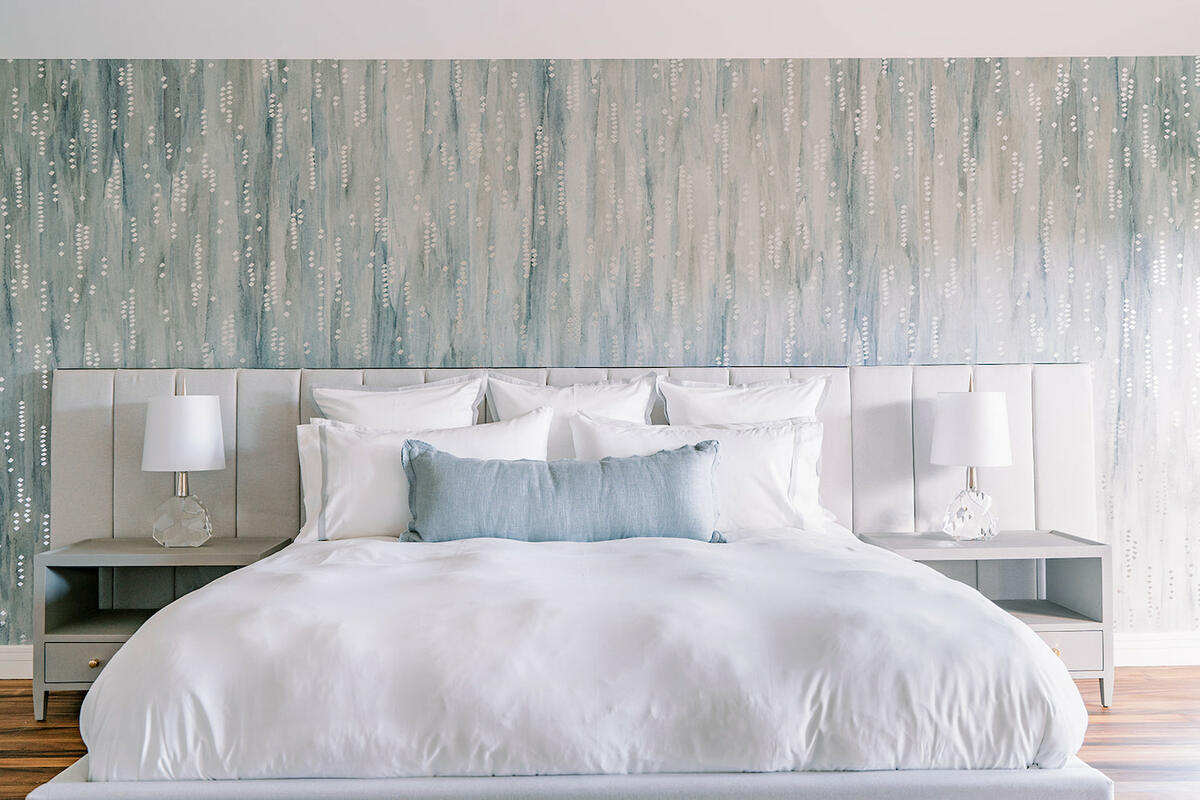
When you decide to make a pivot like that, where do you start?
I thought I was going to slowly transition the staging business—start making changes and see if anyone noticed. At the same time, my mom got a client whose project was too small for her and said, “I can mentor you through it, and I think it’d be a good fit for you.” I went to the first meeting with her, the clients and I hit it off, and she never came to a meeting again—I just went with it, and it ended up becoming a renovation and full-home furnishing. That was in December 2020. In February, I got three more clients. That’s when I realized, “I don’t know what I’m doing.” So I started going on Facebook groups to see what designers are saying about vendors. I was getting books at the library. And I have one friend from school who’s a designer, so I started calling her when I was really stuck. But mostly, I was doing it from scratch. So I was listening to podcasts and basically giving myself a crash-course in design while doing those four projects. When I finished, the clients were so happy, and I was like, “Holy shit, who designed this?” They looked amazing.
Where did you go from there?
I signed up for Studio Designer and hired a bookkeeper to teach me the program top to bottom so that I’d know how to run the business. At the same time, I hired Shaye Price from Brand Identity PR. I had no [photographed] projects yet, and no money, but I went to school for PR and I knew that’s what I needed to push forward. She believed in me from the beginning. I was like, “I have four projects I’ll be shooting this summer, but in the meantime, just put me out there. I need the traction.”
By September, I had hired my first employee. She had DMed me three times, emailed me, and was just like, “I want to work with you.” I was honest with her—I said, “I don’t know if I have a job for you because I don’t really know what’s happening. But if you want to come on part-time and do random stuff, OK?”
What made you realize you needed to start hiring?
I didn’t know I needed to start hiring. Ashley [Fonseca], who’s still with me, just decided that she would be my first hire and made it so. At the time, I was doing everything on my own, and it was fine. But she reached out to me enough that it made me think, “Wow, this is someone who’s really interested in what I’m doing. I should give her some time and talk to her.” And she was smart because she was flexible. She was like, “I’ll come and do whatever, I just want to be a part of it.” She didn’t go to design school either, so she had no expectations about the industry—she just thought she might be interested in design. It turns out she’s not, so now she’s our social media and marketing person. After her, it made sense to hire a purchasing and procurement person because we were drowning. So in April 2022, I hired Kara [Fath] to do that. Today there are six of us, including my husband
When did your husband join the team, and what is his role?
He had his own business as a handyman and in construction. In the beginning of 2022, I convinced him to give me six months—to let me hire him exclusively for that time—and he agreed to try it, and it changed everything. There are so many times when I’m like, “Shoot, I need this installed,” or, “Can you fix this? Can you restain this, or repaint this?” He also does a lot of our construction management, visiting job sites. And because my dad is a contractor, we work with him a lot, too. It’s been such a relief knowing that I have people who have my back. It makes me feel more confident about being able to make risky decisions and push myself a little bit farther, because I know that they can catch me.
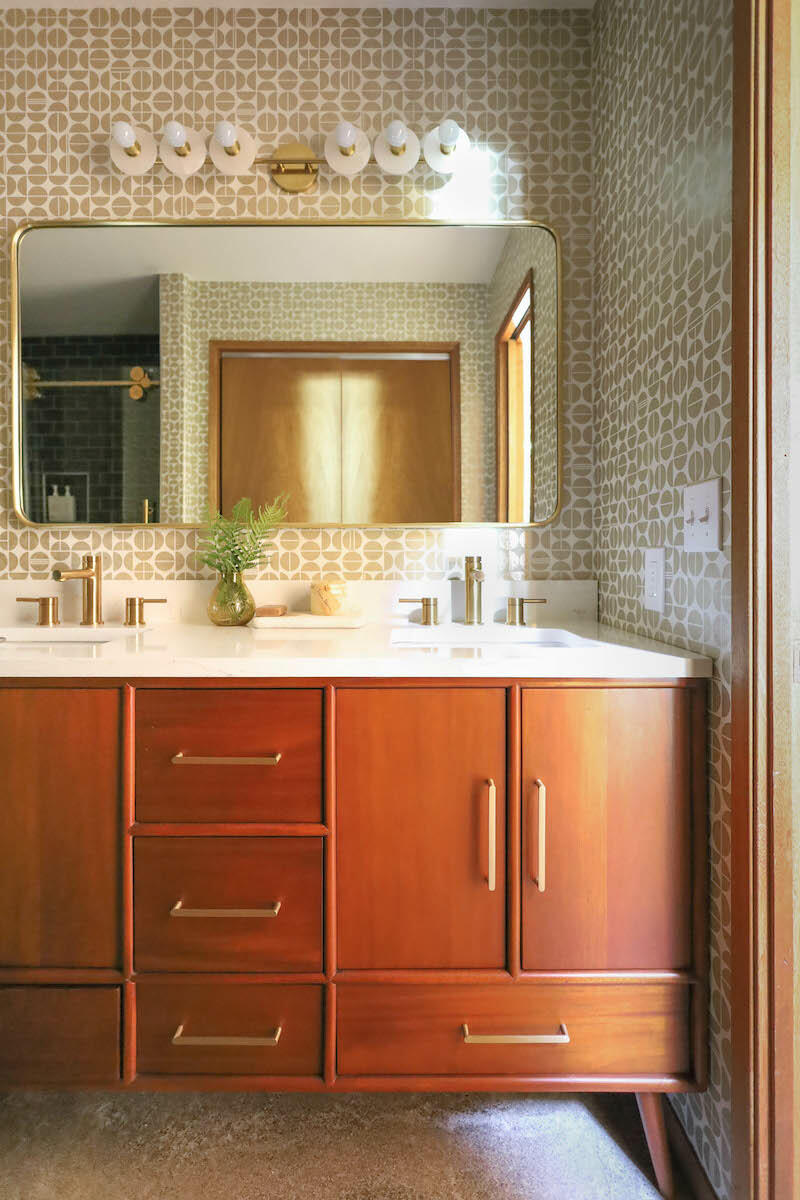
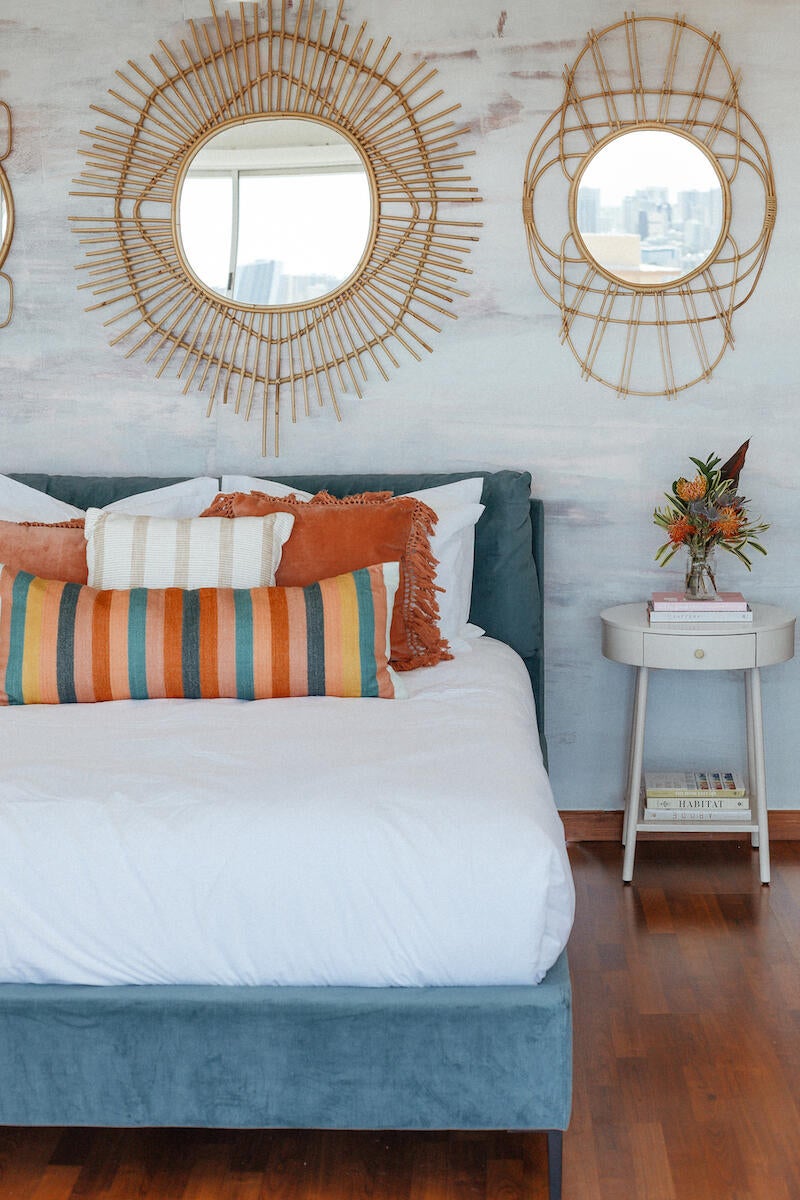
What does the business look like today?
Right now, we’re handling nine to 15 projects at a time. We are also opening a new office with a store. Hawaii is an interesting market because nothing gets shipped here—everything that designers can provide on the mainland, no one can get that [stuff] here. For decades, there have been a couple furniture stores and that’s it. There aren’t that many designers here to hire, and if your budget is not big enough for a designer, then you’re kind of stuck shopping local.
When the store opens, it will be called Woven by Shaolin, and I want to use it to educate, inspire and elevate design across the board for everyone here, so good design isn’t just for, like, the hotels. And eventually, I want the firm to have a nonprofit—I think there’s a lot of opportunity to donate our services for small pro bono projects. We demo so many things that are only gently used, and I’d love to be able to repurpose that and help our community.
For me, 2021 and 2022 were about finishing these projects and developing a portfolio so that we’re established enough that if a big project comes in, people aren’t worried about [whether we can handle it]. We had three condo projects in our portfolio in 2021 when a client from New York picked us out of obscurity for our first million-dollar project. But now my main focus is on building community—whether through the store and the showroom, or a nonprofit—and how we can make a difference here, not just by servicing people who are moving here, but also by working with people who are from here, who live here and who are part of the culture of Hawaii.
How will the store work, when it’s so difficult to get merchandise in?
It’s similar to how designers do it on the mainland in the sense that I use all the same manufacturers and have all those same relationships—the difference is we have everything shipped through a freight forwarder, and there’s that extra time from California to Hawaii on a boat. The unfortunate part is that we can only partner with vendors who understand that no one’s checking it in California—[so] if it arrives damaged in Hawaii, that’s something we have to deal with, and they’re going to have to deal with it with us.
How does that impact your timelines?
Our receiving warehouse in California lets us know when something arrives, and then we determine when we sail it. They can consolidate [items that arrive] for two or three weeks for us if we need, or if we need it right away, they’ll put it on the next boat. They’re sailing every Wednesday and Saturday, so sometimes we’re like, “We need to get on that sail.” If we sail on a Wednesday, we usually get the item on Thursday or Friday the following week. Once it gets here, we can put it in our warehouse and hold it for our client if the project is still under construction. But a lot of our clients are like, “I want my bed. I don’t want to wait.” So we’ll do baby installs along the way, and then when the project is all done, we’ll come in to style and shoot it.
One thing I’m excited about with the store is that we’ll have more in-stock items that I can pull from to furnish the vacation rental projects we’re getting. Right now, we’re doing a lot of purchasing from the mainland, which means that I have to design it within the day once we sign the project so that we can order everything and it can arrive a month later for the install. For those timelines, Amazon Prime has been so great. Those rental projects are on a budget, so we’re shopping there for whatever we can get—window treatments, small accessories, even nightstands or coffee tables. There’s no approval process for those projects. It’s like, “Here’s the money. Just get it done by this date, and we’re good.”
How have you built up your vendor network?
Well, I came into the industry during COVID, so these long lead times were my starting point. I’m starting to see that change, but my expectation is always that everything’s out of stock. I got used to designing based on what’s in stock, or picking vendors who had a shorter lead time, and that was how I built my vendor list. It was: “Hey, how long is it taking you to make this sofa? OK, cool, you make the cut.”
Now some of those vendors have agreed to come on with the e-commerce part of our shop and with our [in-person] showroom, and some of them haven’t, so [my network is] shifting right now. It’s like, “I’m not going to invest in you if you’re not going to invest in me.” Some of them can’t because they have exclusivity agreements with other furniture stores here on the island, and I get that. Honestly, my goal is to not compete with those people—my goal is to bring what we don’t already have here, so I don’t want to carry any brands that are already somewhere [local]. There’s so much opportunity to bring in brands that people aren’t seeing yet.
Who are some of your early partners for the showroom?
Essentials For Living, Made Goods, Union Home Furniture, Alder & Tweed Furniture, Dovetail, Rowe Furniture. And Kravet is going to be a big upholstery partner—they’ve done a lot of heavy lifting to get me up and running, and I’m so excited to be able to provide people with something custom. They were only in this market through designers, but they didn’t have anyone in Hawaii flooring their product.
My dream for the showroom is to have a space where you’re able to come in, sit on the frame, see the quality, and then look at all the different frame options on an iPad and pick from the fabric samples in person. At the same time, we can put a mood board together for you with links to our website—kind of like virtual design, but in person—and you can take that home and shop our site whenever you’re ready. Because not everyone’s always ready to buy all the pieces at one time. No one drop-ships to Hawaii, so everything has to be fulfilled through us to get to where it needs to go.
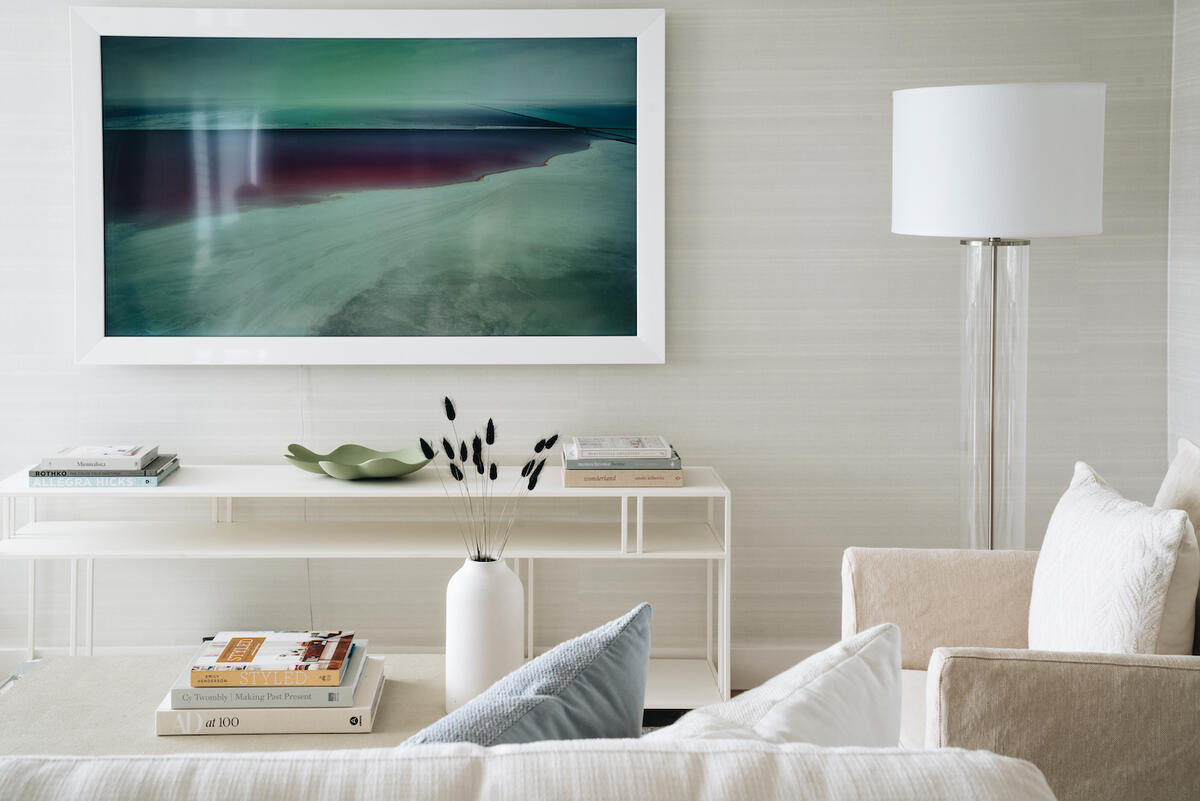
How have you approached billing for your work?
I’ve seen so many people in the industry who feel like they should work for free, and I don’t get that. I’m very money-driven. In that first discovery call with a client, I’m like, “This is how we charge. This is how we make money. This is what you’re going to get, and this is what you’re paying for.” And I think because of that, I’ve never had a client shop me. I’ve never had a client shrink the scope. If anything, they always spend more money than they say they would. Like, I’m always so respectful of their budget, and then they’re the ones blowing their own budget. I’ll be the one who’s like, “Guys, you said you wanted to spend $300,000, and we’re at $450,000. I’m nervous, are you?” And they’re like, “No, this is great. We’re happy.” We charge a flat fee for design and a markup on products, which I learned from Sandra Funk’s course. It’s OK to make money part of the conversation from the very beginning—you’re in business to make money, that shouldn’t be a secret, and you shouldn’t be sorry that you’re making a healthy profit.
I love that you’ve normalized your firm’s fees. Do those shipping surcharges trip people up, or are Hawaiians just conditioned to paying a lot for shipping?
Your milk, your eggs—everything you buy here is shipped in, so if you’re a local, you’re used to it. But a lot of our clients aren’t from here, so they’re shocked at how much it costs. And even sometimes when it’s a local client, even though they’re used to it, they’re like, “Ugh, I don’t want to pay for shipping.” And I get it, because I feel that way too.
With Woven, we’re baking the shipping into the price of the pieces, because if you showed people that a sofa costs $800 to ship, they’re going to say, “Forget it.” So our store price point is going to be higher than mainland retail because of the shipping, but our interior design clients will pay retail and we’ll keep the shipping separate.
What is your warehouse situation to make all of this come to life?
I had a warehouse from the home staging business until August of this past year, but shockingly enough, we did not use it that much. Because most of our clients don’t live here, we can store stuff in their garage while we’re renovating their house. Or if they do live here, it turns out they want their stuff more than they want a big reveal. When their furniture arrives, we time it so that we can install it right away. And so I got rid of that storage space.
I recently bought an acre—which doesn’t sound like a lot when you’re living on the mainland, but here it’s a ton of land—which is 10 minutes away from our showroom, and I’m going to build a warehouse to stock and store everything. We’ll also be able to handle the customer stuff in-house, because we’re going to have to be more intentional about scheduling deliveries. It’s not going to be like with our clients, “Hey, can we come next Friday and drop this off?”
What are some of the other constraints that are unique to Hawaii?
A lot of the houses here are single-wall construction and prefab homes, and they’re all deteriorating. You think you’re getting into one thing, and then you open the walls and it’s something totally different. That’s true of construction anywhere, but what’s hard about that here is that the materials are not here when you run into those issues. So then you’re waiting, right?
Another challenge is the mold, humidity and exposure to sun and salt air all the time. I did a home staging job once where we put a rug down, and when we came to pick it up a month later, there was an imprint on the flooring. Even wood flooring is challenging here. It’s indoor-outdoor living, and we’re wet all the time. There’s sand. Everyone has animals. It’s very much what you think of as an island lifestyle. That means that only the super high-end homes with climate-controlled environments can have wood flooring because of the heat. Also, almost none of the houses here have air-conditioning, or if you do, it’s split air in the bedroom.
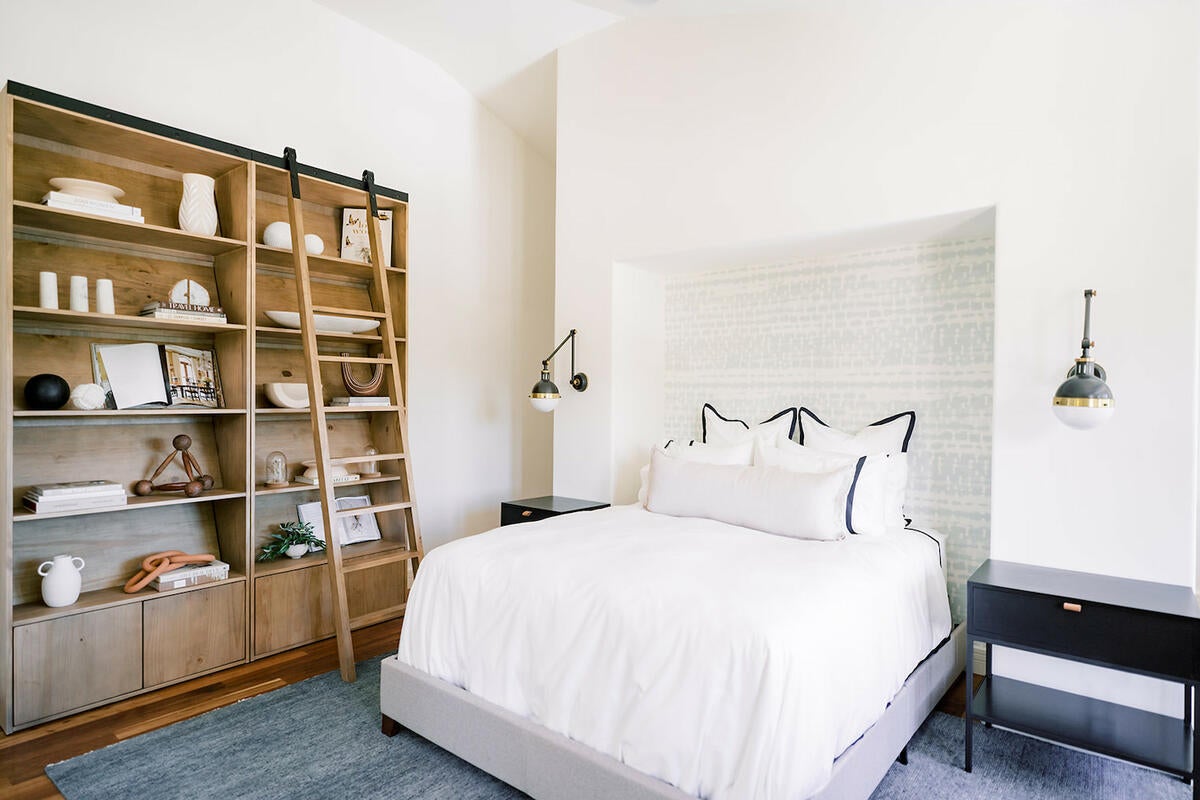
At the top of this call, you told me that you do not think of yourself as a creative person. That’s not something that I hear very often. I think of design as inherently creative, but I wonder if you see it through a different lens?
I look at design as a solution to a problem. Your problem is you’re not comfortable. Your problem is that it’s not functional, or it’s not organized well, or that no one is thriving in this space. That’s a problem. If you live in an ugly environment that doesn’t feel like you, that’s a huge problem to me. So the way that I design is, “Tell me what your problem is, and I’ll find you a solution through these products and through this renovation.” I guess I’m creative in that way. When I think of a creative person, I think of an artist—someone who creates something from nothing. But I don’t feel like I’m creating something from nothing, even though maybe I am.
When I meet really creative people—where it’s their being, or part of who they are—I’m intimidated by them. I’m more about the experience and the journey and the vibe. It’s not my life’s work in that way. What really makes me happy is the end result, when the client is telling me, “I’ve designed four living rooms with other designers, and this is my favorite one.” That human interaction means more to me than the design.
What is the biggest thing you know now that you wish you knew when you were starting out?
Everything you’re told about why you can’t do something isn’t real. And also that your biggest superpower will be something that you think everyone has. Like, I thought everyone saw space and color and life the way I do—and I still forget sometimes that they don’t. That’s my superpower, but I didn’t know that for a long time because I just thought it was within everyone. My love for human stories and connection? Same thing. I’ve been solving people’s problems since I was a child—I have so many stories of strangers that I’ve just met telling me their problems, asking for advice, and then I’m leaving that train station or plane thinking, “Well, I hope they have a great life.”
Oh, my gosh, I’m the same way. People always want to talk to me on planes, and I love hearing their life stories. Then again, I say all the time that I get to be professionally nosy. It’s my job.
I’m so jealous—though in a way, I do, too. I get to go in and say, “Do you guys bathe together? Is it important that we have a tub for one or two? Where is he sleeping? Why is he sleeping there? Oh, your family comes to visit, and that’s really stressful for you? Why is that?” It’s so much fun. If you ever want to be a designer, you’d be amazing at it because you know how to ask the uncomfortable questions.
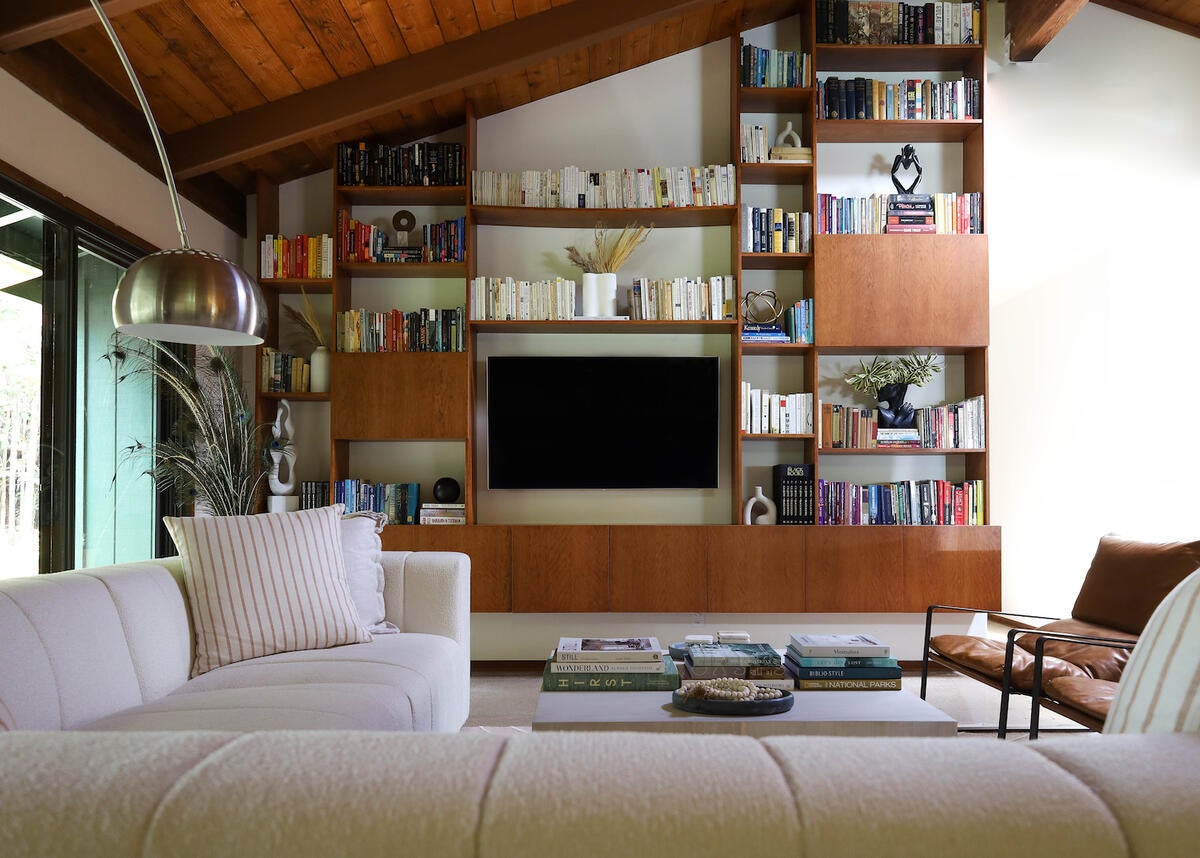
As your firm grows, what are the things you would never want to delegate away? What are the things that you always want to keep for yourself?
Oh, my god, that’s so interesting because I love to delegate. I would be more than happy to share the design, or the finance work. The one thing I don’t think I can delegate is the vision—that’s something that will always belong to me, and it will always be my job to keep the vision and the brand and the culture to be truly what I want it to be. But everything else? I hope I outgrow everything else.
Now that’s a vision. What would that look like?
I was joking with a friend, like, “How successful do you need to be to not even hold a cell phone?” That would be my dream: to be so high-level to not field phone calls or text messages. But really, my goal is to have a bunch of designers who are like their own little companies within my company, and we’re supporting them in the back office. My dream for the showroom and store is to be able to service the community and grow.
What does success look like to you?
Oh, my gosh, I think about this question every single time you ask [your guests] on Trade Tales, and I never know what I’d say. But I was just listening to your interviews with Pure Salt Interiors and Jenny Wolf, and I was thinking about how success looks like that feeling you get when you know you changed somebody’s life—when you know that you’ve impacted them in a way that only good design and the core of who you are could do. And I feel that success every time we finish a project, when a client looks at me and says, “I feel like my best self when I’m in this home, and I never knew what that felt like before.” That, to me, is enough.
Knowing you’ve made a difference that way is so moving.
It feels so good to be a part of people’s lives in that way. I have to tell you—I was at a project in Kauai one day when the [client] was home. He’s an important ear, nose and throat surgeon. The project has a big bookshelf, and I was going through the books, talking to myself as I color-coded them. He was laughing at me—in a playful way, we’re friends at this point—and I was like, “What’s so funny?” He said, “You’re taking this so seriously.” And I said to him, “Look, we can’t all be saving people’s lives, but what I’m doing for you here is going to rejuvenate you so that you can.” And what’s crazy is a few weeks later, they gave birth to their firstborn child in front of that bookshelf. The wife did a home birth, and she called me a couple of weeks ago and said, “Send me your Google review link, because I just got this overwhelming feeling of how much you’ve impacted our lives by what you did for us, and I want to let everyone know.”
You’re bringing a baby into this world that I helped you create? How is there anything better than that? That’s why I’m going to keep dreaming, keep pushing myself and keep enjoying the journey.
To learn more about Shaolin Low, visit her website or find her on Instagram.





























